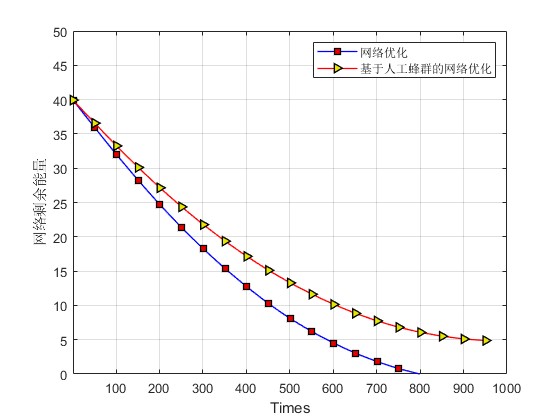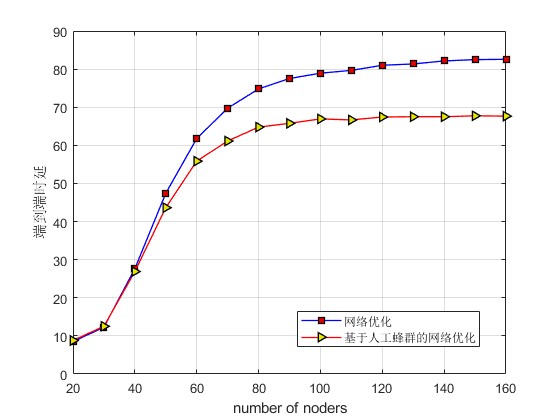1.完整项目描述和程序获取
>面包多安全交易平台:https://mbd.pub/o/bread/ZJaamZlu
>如果链接失效,可以直接打开本站店铺搜索相关店铺:
>如果链接失效,程序调试报错或者项目合作也可以加微信或者QQ联系。
2.部分仿真图预览


3.算法概述
传感器节点通常布置在无人值守的运行环境中,节点能量由电池提供,但在使用过程中,电池的更换很不方便,因此无线传感器网络必须考虑如何解决能量有限的问题。因此,研究无线传感器网络优化算法以找到最大限度地减少能耗和提高无线传感器网络可靠性的最佳路径是非常重要的。
4.部分源码
....................................................................
%network topology
dmatrix= zeros(Nnode,Nnode);
matrix = zeros(Nnode,Nnode);
Trust = zeros(Nnode,Nnode);
for i = 1:Nnode
for j = 1:Nnode
Dist = sqrt((X(i) - X(j))^2 + (Y(i) - Y(j))^2);
%a link;
if Dist <= Radius
matrix(i,j) = 1;
Trust(i,j) = 1-((T(i)+T(j))/2);
dmatrix(i,j) = Dist;
else
matrix(i,j) = inf;
Trust(i,j) = inf;
dmatrix(i,j) = inf;
end;
end;
end;
pathS = 1;
pathE = Nnode;
.......................................................................
%Get the best weight
w1s=cpop(1,1);
w2s=cpop(1,2);
w1 = w1s/(w1s + w2s);
w2 = w2s/(w1s + w2s);
%%%%%%%%%%%%%%%%%%%%%%%%%%%%%%%%%%%%%%%%%%%%%%%%%%%%%%%%%%%%%%%%%%%%%%%%%%%%%
for ni = 1:length(Nnodes);
ni
%节点个数
Nnode = Nnodes(ni);
Delays2 = zeros(1,MTKL);%end-to-end delay
consmp2 = zeros(1,MTKL);%Network topology control overhead
Srate2 = zeros(1,MTKL);%Packet delivery rate
for jn = 1:MTKL
X = rand(1,Nnode)*SCALE;
Y = rand(1,Nnode)*SCALE;
T = rand(1,Nnode);
Delays = zeros(Times,1);
consmp = zeros(Times,1);
Srate = zeros(Times,1);
for t = 1:Times
if t == 1
X = X;
Y = Y;
else
%Nodes send random moves
X = X + Vmax*rand;
Y = Y + Vmax*rand;
end
%network topology
dmatrix= zeros(Nnode,Nnode);
matrix = zeros(Nnode,Nnode);
Trust = zeros(Nnode,Nnode);
for i = 1:Nnode
for j = 1:Nnode
Dist = sqrt((X(i) - X(j))^2 + (Y(i) - Y(j))^2);
%a link;
if Dist <= Radius
matrix(i,j) = 1;
Trust(i,j) = 1-((T(i)+T(j))/2);
dmatrix(i,j) = Dist;
else
matrix(i,j) = inf;
Trust(i,j) = inf;
dmatrix(i,j) = inf;
end;
end;
end;
%Defines the communication start node and termination node
tmp = randperm(Nnode);
for i = 1:Nnode
distA(i) = sqrt((X(i))^2 + (Y(i))^2);
distB(i) = sqrt((X(i)-SCALE)^2 + (Y(i)-SCALE)^2);
end
[Va,Ia] = min(distA);
[Vb,Ib] = min(distB);
Sn = Ia;
En = Ib;
[paths,costs] = func_dijkstra_BF(Sn,En,dmatrix,Trust,w1,w2);
path_distance=min(Va,Vb);
for d=2:length(paths)
path_distance= path_distance + dmatrix(paths(d-1),paths(d));
end
%end-to-end delay
path_hops = min(length(paths)-1,1);
%The delay is calculated based on distance, packet length, and data packet rate
Delays(t) = path_distance*(SLen/Smax)/1e3;
%%%%%%%%%%%%%%%%%%%%%%%%%%%%%%%%%%%%%%%%%%%%%%%%%%%%%%%%%%%%%%%
%Packet delivery rate
Ps = rand/5;
tmps = 0;
for ii = 1:path_hops
tmps = tmps + path_distance*Ps^ii/1e3;
end
Srate(t) = 1-tmps;
%%%%%%%%%%%%%%%%%%%%%%%%%%%%%%%%%%%%%%%%%%%%%%%%%%%%%%%%%%%%%%%
%Network topology control overhead
consmp(t)= 1000*path_distance*(Eelec+Eelec+Efs);
%%%%%%%%%%%%%%%%%%%%%%%%%%%%%%%%%%%%%%%%%%%%%%%%%%%%%%%%%%%%%%%
end
Delays2(jn) = mean(Delays);
Srate2(jn) = mean(Srate);
consmp2(jn) = mean(consmp);
end
ind1 = find(Delays2 > 1e5);
ind2 = find(Delays2 < 0);
ind = unique([ind1,ind2]);
Delays2(ind) = [];
Delayn(ni) = mean(Delays2);
ind1 = find(Srate2 > 1);
Srate2(ind1) = [];
Sraten(ni) = mean(Srate2);
ind1 = find(consmp2 < 0);
consmp2(ind1)= [];
consmpn(ni) = mean(consmp2);
end
figure;
for i = 1:Nnode
plot(X(i),Y(i), 'ro');
text(X(i),Y(i), num2str(i));
hold on
end
for i = 1:length(paths)-1
line([X(paths(i)) X(paths(i+1))], [Y(paths(i)) Y(paths(i+1))], 'LineStyle', '-');
hold on
end
figure;
plot(Nnodes,Delayn,'b-o');
grid on
xlabel('number of noders');
ylabel('End-To-End delay');
axis([Nnodes(1),Nnodes(end),0,120]);
figure;
plot(Nnodes,Sraten,'b-o');
grid on
xlabel('number of noders');
ylabel('Packet delivery rate');
axis([Nnodes(1),Nnodes(end),0.8,1.05]);
figure;
plot(Nnodes,consmpn,'b-o');
grid on
xlabel('number of noders');
ylabel('Energy consumption');
axis([Nnodes(1),Nnodes(end),0,0.1]);
save R_new1.mat Nnodes Delayn Sraten consmpn
12_034_m





































